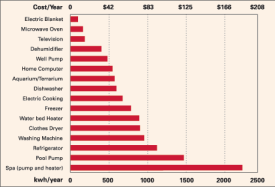How Much Electricity Does Your Home Really Use?
 Saving electricity. Everybody's talking about it, but what does the idea really mean? Before you start planning ways to cut down on your electricity consumption, it would be helpful to know how much electrical power you're currently using in the home, and what you're using it for. Here's a guide.
Saving electricity. Everybody's talking about it, but what does the idea really mean? Before you start planning ways to cut down on your electricity consumption, it would be helpful to know how much electrical power you're currently using in the home, and what you're using it for. Here's a guide.
What Are Watts, Kilowatts, and Kilowatt Hours?
The US Energy Information Administration (EIA) reports that in 2013 the average American home used 10,908 kilowatt hours (kWh) of electricity per year, or about 909 kWh per month.
What does this mean to the average person? Well, a watt is a measure of power, and 1000 of them equal one kilowatt (often shortened to kW). A kilowatt hour (kWh) is a measure of energy -- the number of kilowatts used per hour. The kWh is the unit by which your local utility company calculates the electricity consumption of their residential customers, meaning the charge on your monthly or bimonthly bill works out to the number of kilowatt hours you used, multiplied by the company's billing rate per kWh.
How Much Electricity Do Your Appliances Use?
The electricity consumption of your household appliances varies widely, depending on their size and model, the temperature or speed setting you choose, and your local climate. However, learning the approximate power rating of home appliances will help you track your home electricity consumption.
ELECTRICAL APPLIANCE | RATING |
Air conditioner, central (2.5 ton) | 3800 watts |
Air conditioner, window unit | 500-1400 watts |
Blow dryer | 1000 watts |
Broadband router | 7-10 watts |
Coffee maker | 900 watts |
Deep fryer | 1200 watts |
Dehumidifier | 300-700 watts |
Desktop computer | 80-150 watts |
Dishwasher | 1050-1500 watts |
Electric blanket | 130-200 watts |
Electric drill | 900-1000 watts |
Electric lawn mower | 500-1500 watts |
Extractor fan | 1-36 watts |
Freezer | 150 watts |
Fridge-freezer | 200-400 watts |
Game console | 45-190 watts |
Grill | 1000-2000 watts |
Iron | 1000-1800 watts |
Kettle | 2200-3000 watts |
Laptop | 20-50 watts |
LCD TV | 125-200 watts |
Microwave | 600-1500 watts |
Oil-filled radiator | 1500-2500 watts |
Oven | 2000-2200 watts |
Oven, self-cleaning mode | 1180 watts |
Plasma TV | 280-450 watts |
Refrigerator | 40-120 watts |
Smart phone (charge) | 2.5-5 watts |
Space heater | 2000-3000 watts |
Stove burner | 800 watts |
Tablet (charge) | 10 watts |
Toaster | 800-1500 watts |
Towel rail | 250 watts |
Tumble dryer | 2000-4000 watts |
Vacuum cleaner | 500-1200 watts |
Video, DVD or CD | 20-60 watts |
Washing machine | 1200-3000 watts |
Water Heater | 3800 watts |
Chart adapted from the Centre for Sustainable Energy
For a more precise measurement, you can check 120-volt appliances with an electricity usage monitor. This will track the wattage drawn with normal use and also the "phantom load" when the device is turned off.
How Can You Reduce Your Electricity Usage?
1. Start with HVAC. If you're looking to cut down on your electricity consumption -- and your electricity bills! -- start with your HVAC usage. Heating and cooling the home accounts for nearly half of residential electric consumption. So you can save by changing your HVAC filter, insulating your home, installing ceiling fans, buying a programmable thermostat, and setting the temperature at an energy-smart 78 degrees in summer and 68 degrees in winter.
2. Unplug. Reduce phantom load electricity consumption by unplugging infrequently-used appliances, substituting energy-saving plugs for your current ones (pun intended), or turning them off with a power strip.
3. Look for the Energy Star. When you're ready to buy a new air conditioner, furnace, fridge, or other major appliance, look for Energy Star certification. And if you're on the fence about whether you can afford to upgrade, consider the energy savings and improved performance a new model will give you.
4. Use less. A few examples to get you started: Hang your clothes to dry, at least in summer. (I do.) Wear more layers in winter so you can set the heat lower. Plan your oven use so that you bake several items at the same time.
5. Go solar. Consider moving to solar power. If you are not ready to make a major commitment, some areas offer the possibility of solar leasing.
6. Talk to a pro. Consult a professional electrician for more recommendations on how to reduce your home electricity consumption.
Laura Firszt writes for networx.com.
Updated Ocotber 7, 2018.
Looking for a Pro? Call us (866) 441-6648

Heating & cooling Average Costs
HVAC Contractors Experiences

Hardworking Handyman Brings Christmas To Southern California

Smoke Detector Replacement Was Done Well And Saved Us Money



